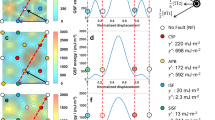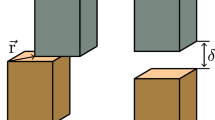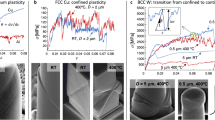Abstract
The search for deformation mechanisms in nanocrystalline metals has profited from the use of molecular dynamics calculations. These simulations have revealed two possible mechanisms; grain boundary accommodation, and intragranular slip involving dislocation emission and absorption at grain boundaries. But the precise nature of the slip mechanism is the subject of considerable debate, and the limitations of the simulation technique need to be taken into consideration. Here we show, using molecular dynamics simulations, that the nature of slip in nanocrystalline metals cannot be described in terms of the absolute value of the stacking fault energy—a correct interpretation requires the generalized stacking fault energy curve, involving both stable and unstable stacking fault energies. The molecular dynamics technique does not at present allow for the determination of rate-limiting processes, so the use of our calculations in the interpretation of experiments has to be undertaken with care.
This is a preview of subscription content, access via your institution
Access options
Subscribe to this journal
Receive 12 print issues and online access
$259.00 per year
only $21.58 per issue
Buy this article
- Purchase on Springer Link
- Instant access to full article PDF
Prices may be subject to local taxes which are calculated during checkout



Similar content being viewed by others
References
Yamakov, V., Wolf, D., Phillpot, S.R., Mukherjee, A.K. & Gleiter, H. Deformation-mechanism map for nanocrystalline metals by molecular-dynamics simulation. Nature Mater. 3, 43–47 (2004).
Schiøtz, J., Di Tolla, F.D. & Jacobsen, K.W. Softening of nanocrystalline metals at very small grain sizes. Nature 391, 561–563 (1998).
Schiøtz, J., Vegge, T.F., Di Tolla, D. & Jacobsen K.W. Atomic-scale simulations of the mechanical deformation of nanocrystalline metals. Phys. Rev. B 60, 11971–11983 (1999).
Schiøtz, J. & Jacobsen, K.W. A maximum in the strength of nanocrystalline copper. Science 301, 1357–1359 (2003).
Van Swygenhoven, H. & Derlet, P.M. Grain-boundary sliding in nanocrystalline fcc metals. Phys. Rev. B 64, 224105 (2001).
Van Swygenhoven, H., Derlet, P.M. & Hasnaoui, A. Atomic mechanism for dislocation emission from nanosized grain boundaries. Phys. Rev. B 66, 024101 (2002).
Derlet, P.M., Van Swygenhoven, H. & Hasnaoui, A. Atomistic simulation of dislocation emission in nanosized grain boundaries. Phil. Mag. 83, 3569–3575 (2003).
Derlet, P.M., Hasnaoui, A. & Van Swygenhoven, H. Atomistic simulations as guidance to experiments. Scripta Mater. 49, 629–635 (2003).
Van Swygenhoven, H., Derlet, P.M., Budrovic, Z. & Hasnaoui, A. Unconventional deformation mechanism in nanocrystalline metals? Z. Metallk. 94, 1106–1110 (2003).
Van Swygenhoven, H. Grain boundaries and dislocations. Science 296, 66–67 (2002).
Hasnaoui, A., Van Swygenhoven, H. & Derlet, P.M. On non-equilibrium grain boundaries and their effect on thermal and mechanical behaviour: A molecular dynamics computer simulation. Acta. Mater. 50, 3927–3939 (2002).
Hasnaoui, A., Van Swygenhoven, H. & Derlet, P.M. Dimples on fracture surfaces as evidence for shear plane formation in nanocrystalline metals. Science 300, 1550–1552 (2003).
Van Swygenhoven, H. et al. Atomistic studies of plasticity in nanophase metals. Mater. Res. Soc. Symp. Proc. 634, B5.5.1–B5.5.12 (2001).
Derlet, P.M. & Van Swygenhoven, H. Atomic positional disorder in fcc metal nanocrystalline grain boundaries. Phys. Rev. B 67, 014202 (2003).
Cleri, F. & Rosato, V. Tight binding potentials for transition metal alloys. Phys. Rev. B 48, 22–33 (1993).
Mishin, Y., Farkas, D., Mehl, M.J. & Papaconstantopoulos, D.A. Interatomic potentials for Al and Ni from experimental data and ab initio calculations. Mater. Res. Soc. Symp. Proc. 538, 535–540 (1999).
Frøseth, A.G., Van Swygenhoven, H. & Derlet, P.M. The influence of twins on the mechanical properties of nc-Al. Acta Mater. 52, 2259–2268 (2004).
de Koning, M., Cai, W. & Bulatov, V.V. Anomalous dislocation multiplication in fcc metals. Phys. Rev. Lett. 91, 025503 (2003).
Zimmerman, J.A., Gao, H. & Abraham, F.F. Generalized stacking fault energies for embedded atom FCC metals. Model. Simul. Mater. Sci. Eng. 8, 103–115 (2000).
Rice, J.R. Dislocation nucleation from a crack tip: An analysis based on the Peierls concept. J. Mech. Phys. Solids 40, 239–271 (1992).
Tadmor, E.B. & Hai, S. A Peierls criterion for the onset of deformation twinning at a crack tip. J. Mech. Phys. Solids 51, 765–793 (2003).
Hai, S. & Tadmor, H.B. Deformation twinning at aluminium crack tips. Acta Mater. 51, 117–131 (2003).
Farkas, D., Van Swygenhoven, H. & Derlet, P.M. Intergranular fracture in nanocrystalline metals. Phys. Rev. B 66, 60101(R) (2002).
Ercolessi, F. & Adams, J.B. Interatomic potentials from first-principles calculations: The force-matching method. Europhys. Lett. 26, 583–588 (1994).
Yamakov, V., Wolf, D., Phillpot, S.R. & Gleiter H. Deformation twinning in nanocrystalline Al by molecular-dynamics simulation. Acta Mater. 50, 5005–5020 (2002).
Jacobsen, K.W., Stoltze, P. & Nørskov, J.K. A semi-empirical effective medium theory for metals and alloys. Surf. Sci. 366, 394–402 (1996).
Derlet, P.M. & Van Swygenhoven, H. On length scale effects in molecular dynamics simulations of the deformation properties of nano-crystalline metals. Scripta Mater. 47, 719–724 (2002).
Liao, X.C. et al. Deformation twinning in nanocrystalline copper at room temperature and low strain rate. Appl. Phys. Lett. 84, 592–594 (2004).
Liao, X.C., Zhou, F., Lavernia, E.J., He, D.W. & Zhu, Y.T. Deformation twins in nanocrystalline Al. Appl. Phys. Lett. 83, 5062–5064 (2003).
Ogata, S., Li, J. & Yip, S. Ideal pure shear strength of aluminum and copper. Science 298, 807–811 (2002).
Budrovic, Z., Van Swygenhoven, H., Derlet, P.M., Van Petegem, S. & Schmitt, B. Plastic deformation with reversible peak broadening in nanocrystalline nickel. Science 304, 273–276 (2004).
Liao, X.C. et al. Deformation mechanism in nanocrystalline Al: Partial dislocation slip. Appl. Phys. Lett. 83, 632–634 (2003).
Acknowledgements
This work was supported by the Swiss FN (grant no. 200021-100055/1).
Author information
Authors and Affiliations
Corresponding author
Ethics declarations
Competing interests
The authors declare no competing financial interests.
Rights and permissions
About this article
Cite this article
Van Swygenhoven, H., Derlet, P. & Frøseth, A. Stacking fault energies and slip in nanocrystalline metals. Nature Mater 3, 399–403 (2004). https://doi.org/10.1038/nmat1136
Received:
Accepted:
Published:
Issue Date:
DOI: https://doi.org/10.1038/nmat1136
This article is cited by
-
A Novel Metastable Structure in Polycrystalline Metals With Extremely Fine Grains: Schwarz Crystal
Metallurgical and Materials Transactions A (2024)
-
Analysis of Mechanical Behavior and Nanostructural Evolution of the Au/AuAl Alloy Interface
Journal of Materials Engineering and Performance (2024)
-
Atomistic modeling of idealized equal channel angular pressing process
Journal of Materials Science (2024)
-
Chemical inhomogeneity–induced profuse nanotwinning and phase transformation in AuCu nanowires
Nature Communications (2023)
-
Atomistic Simulations of Ductile Failure in a b.c.c. High-Entropy Alloy
High Entropy Alloys & Materials (2023)



